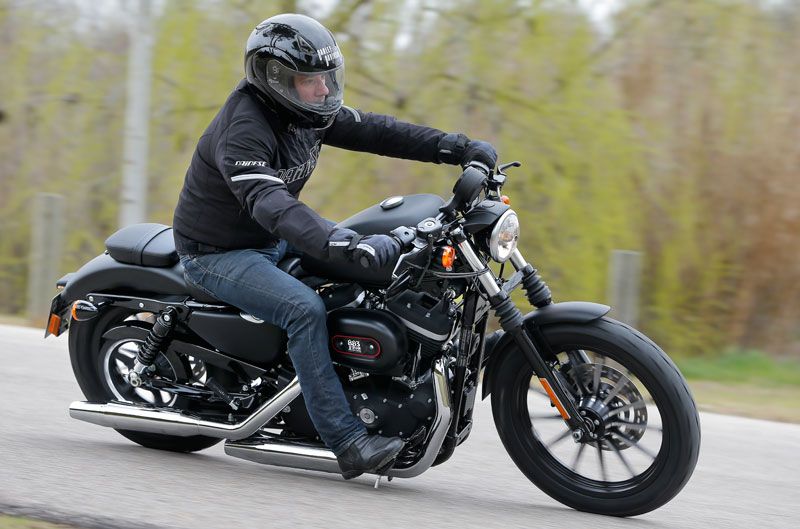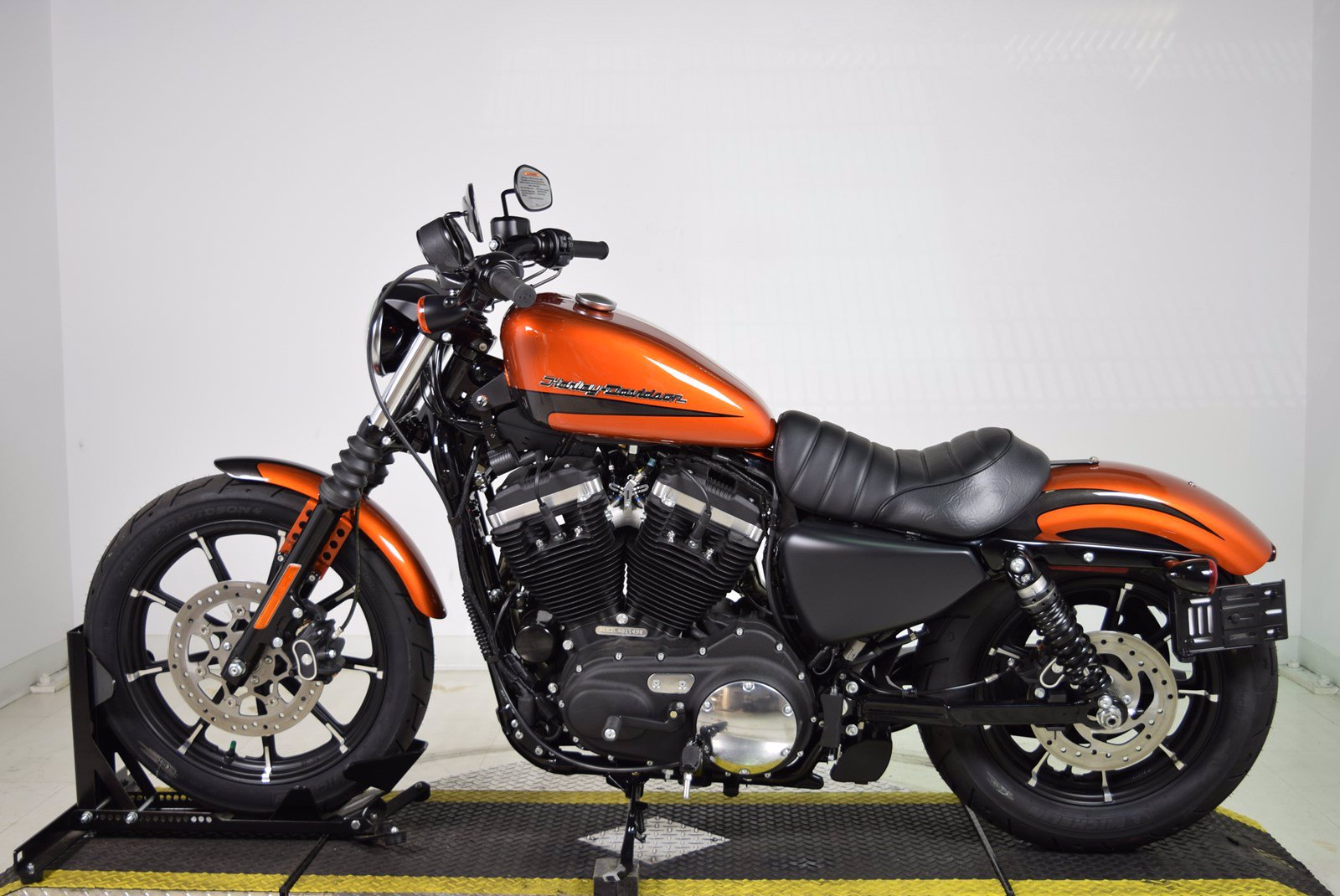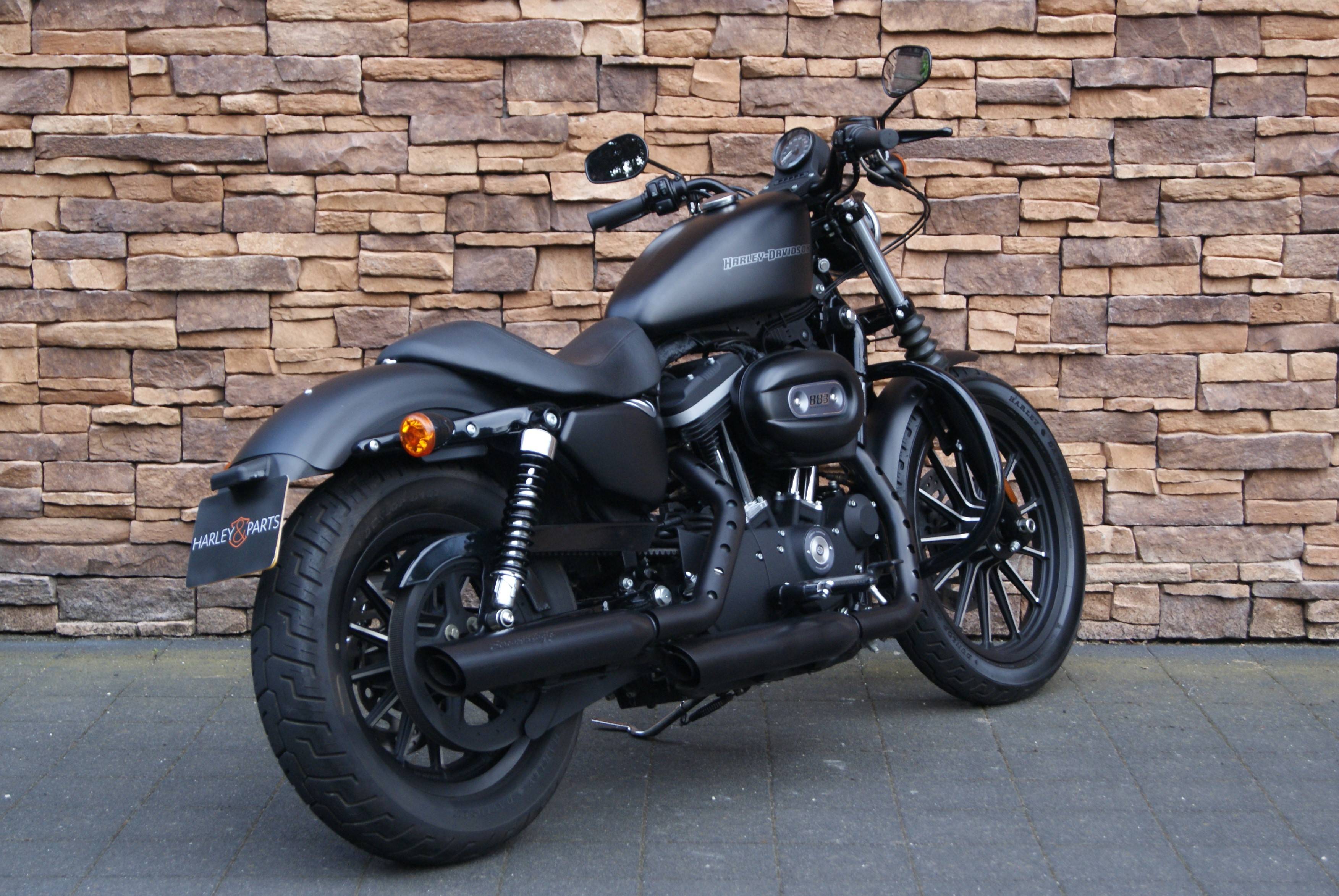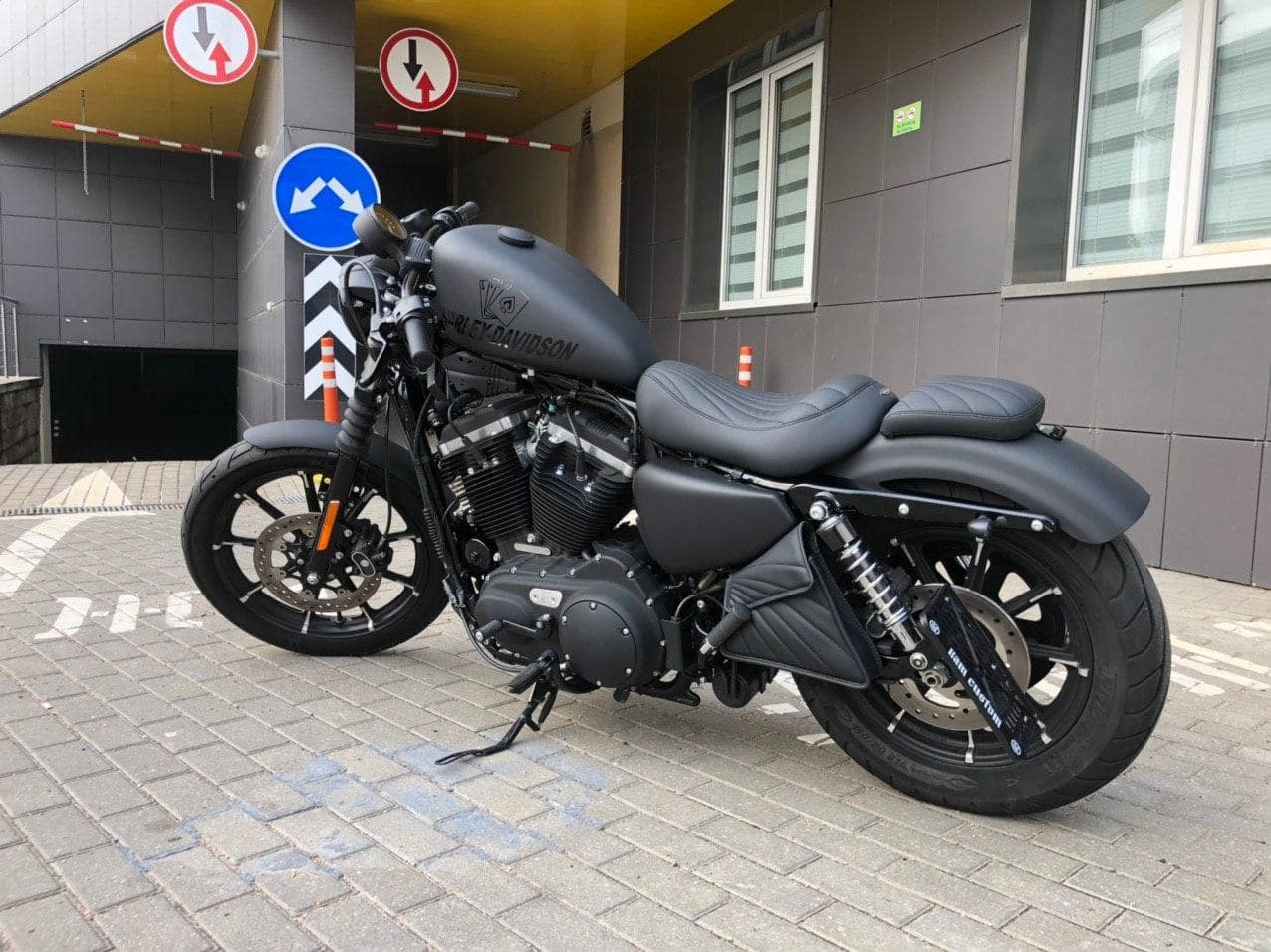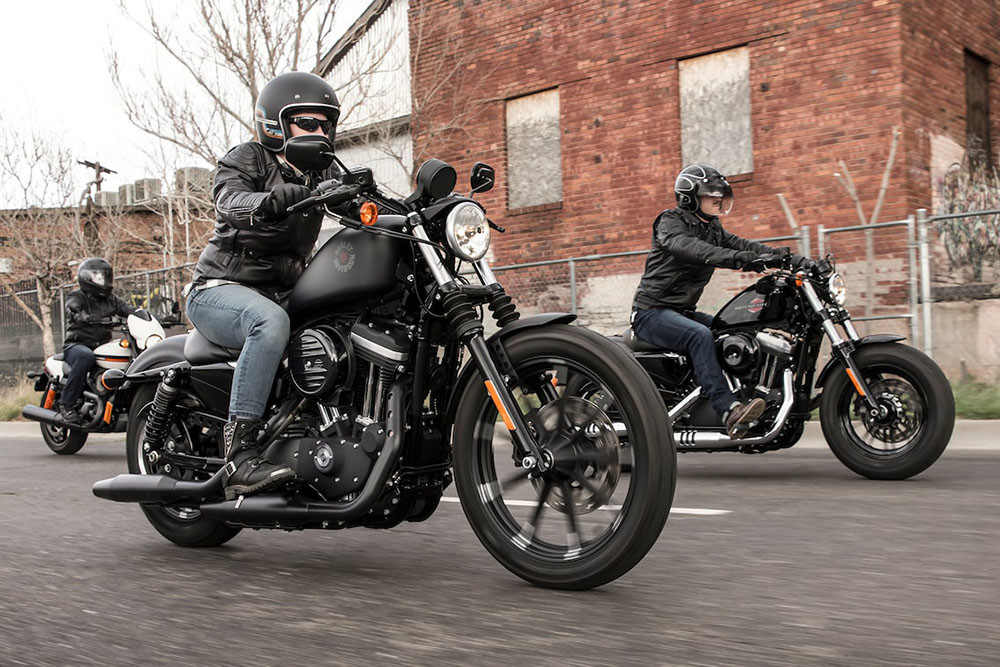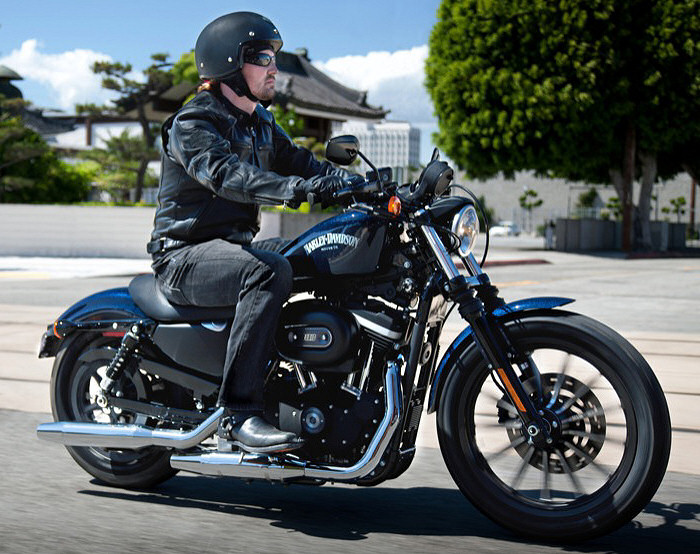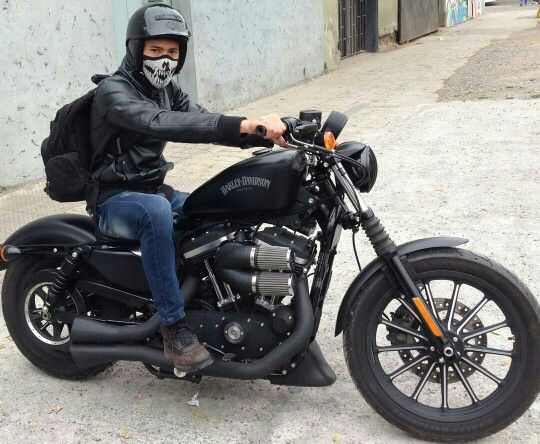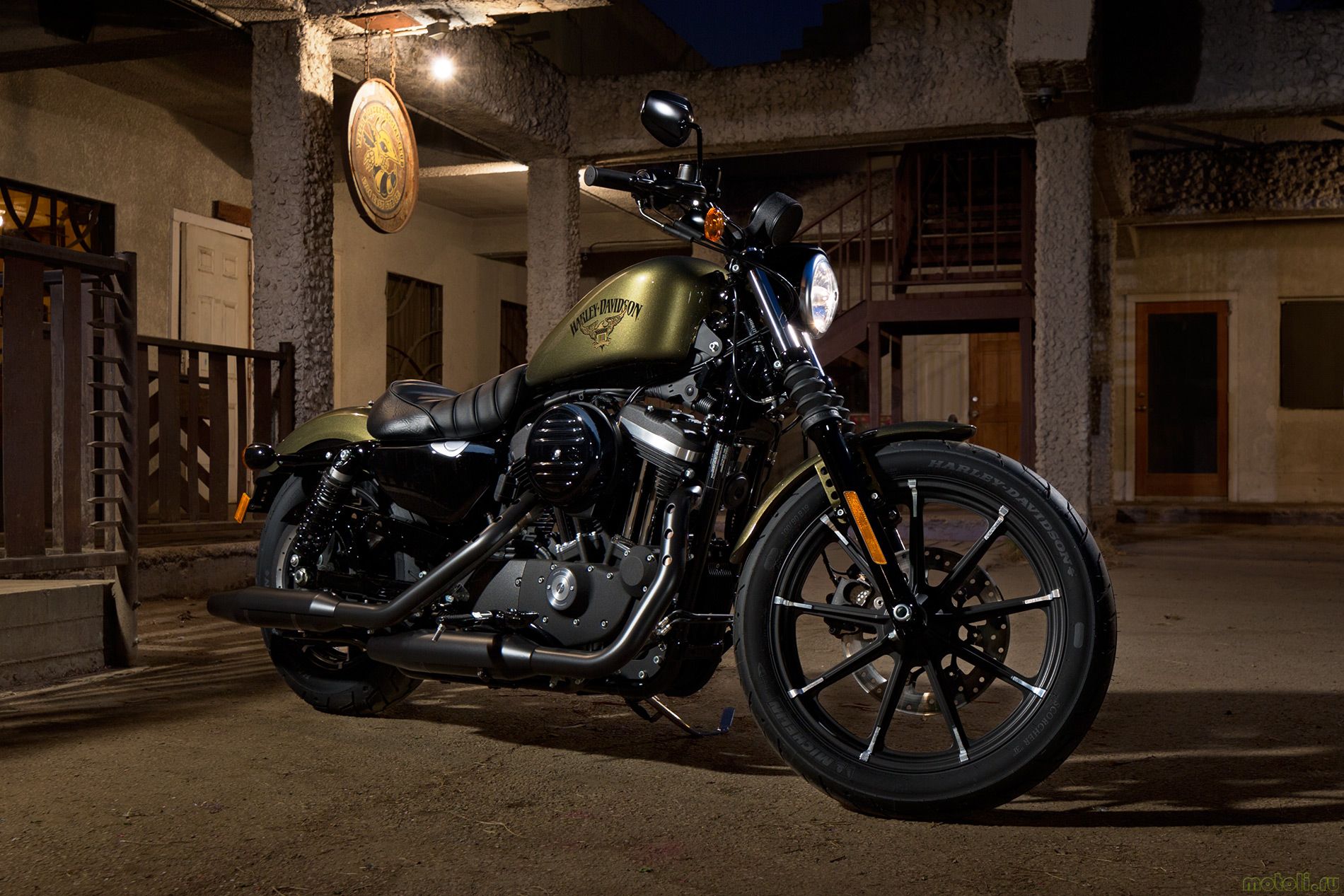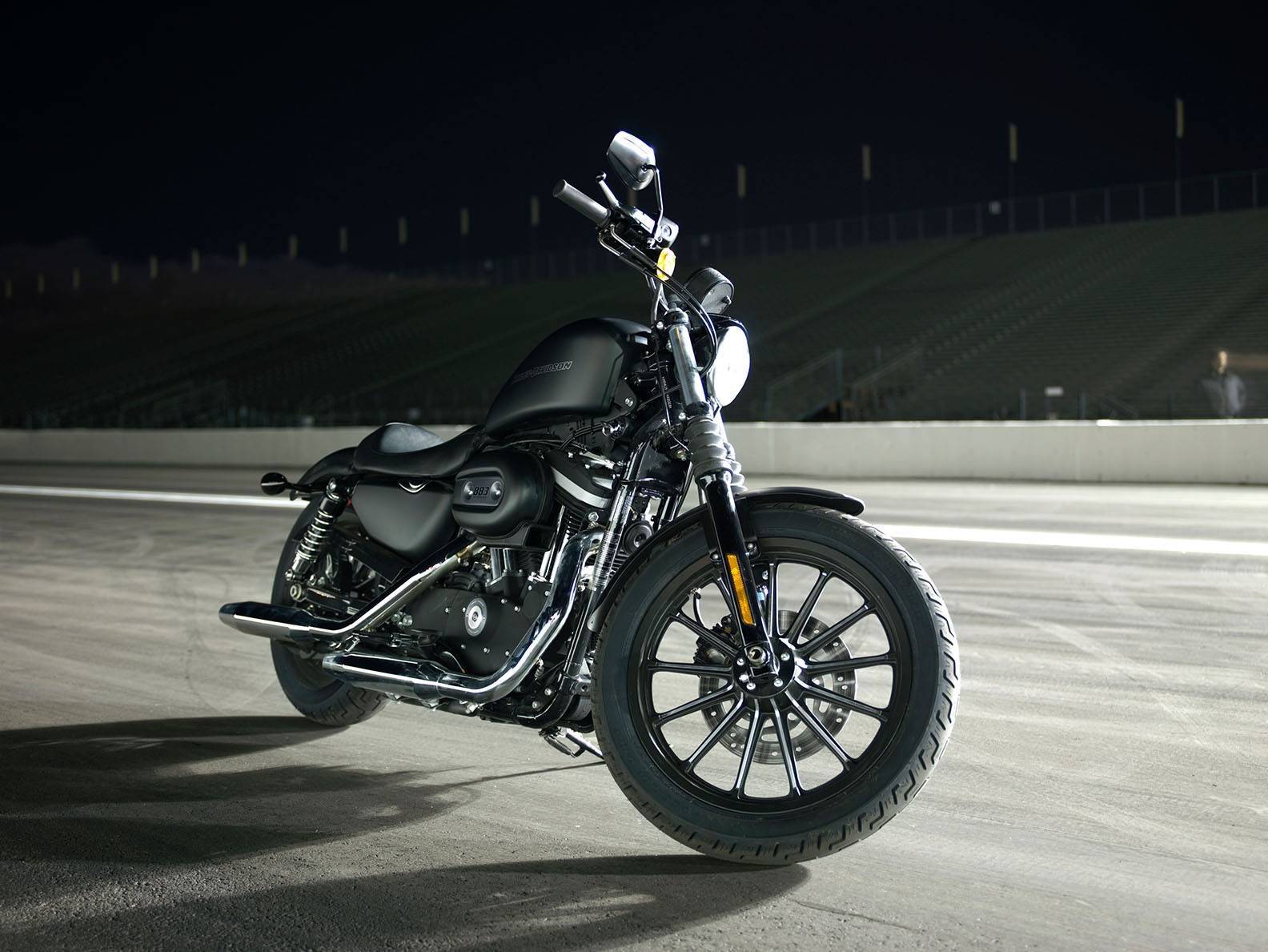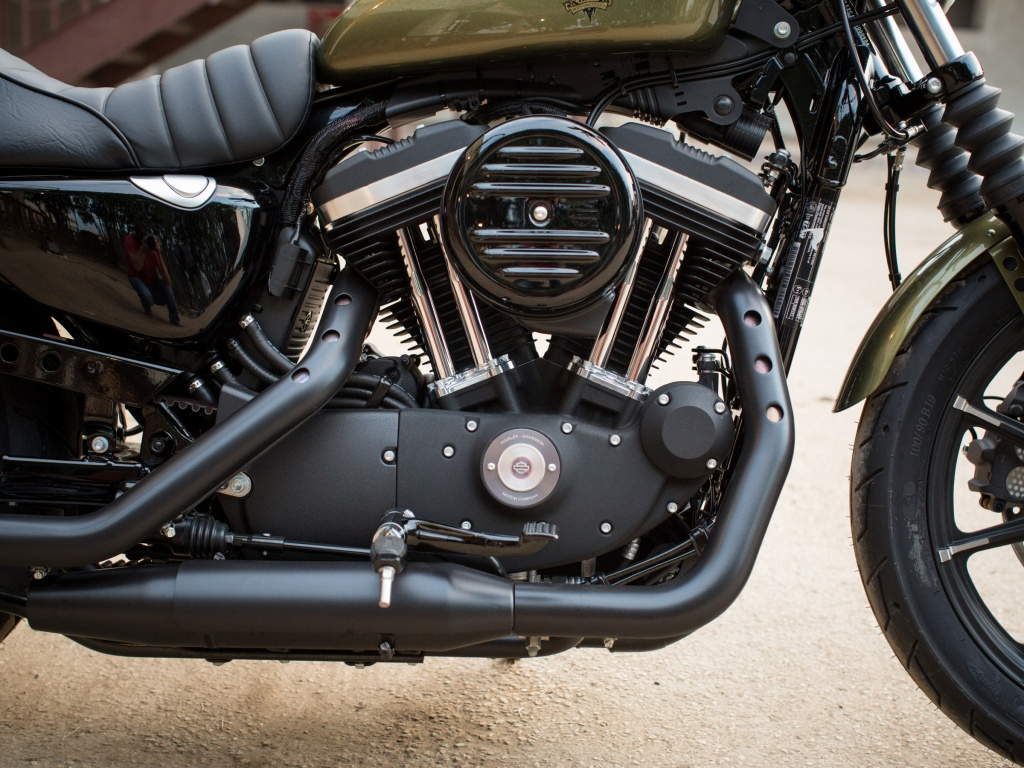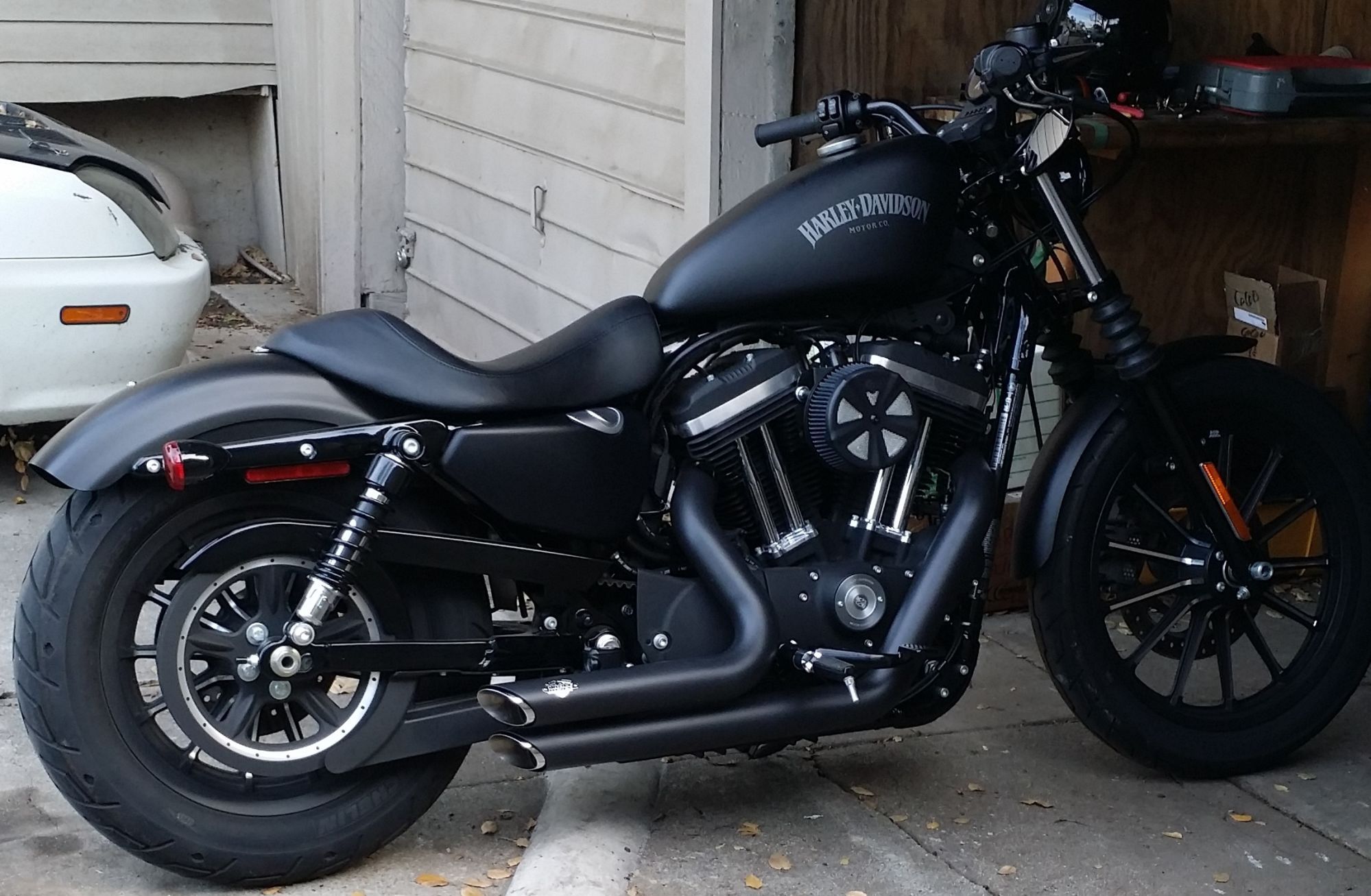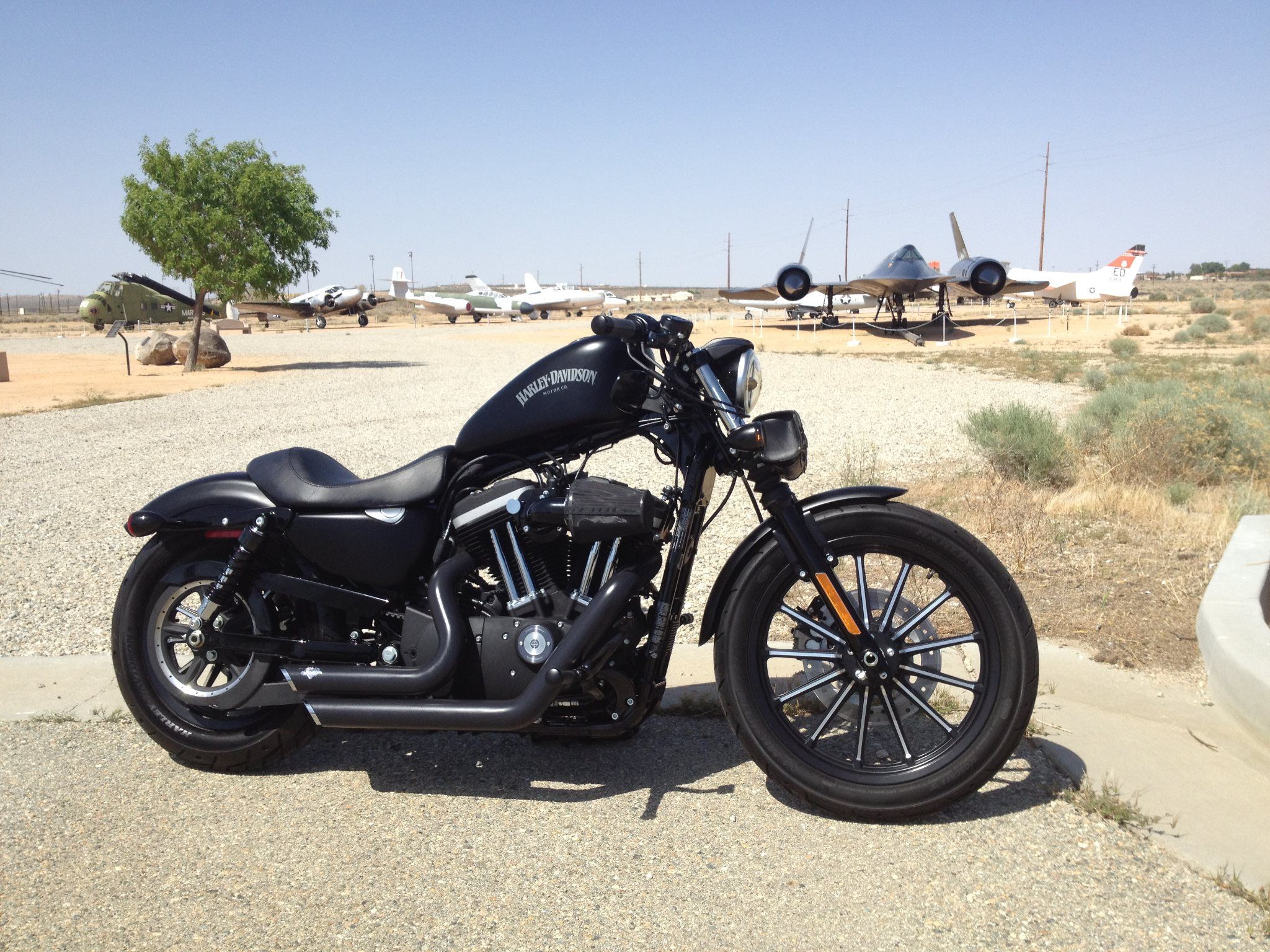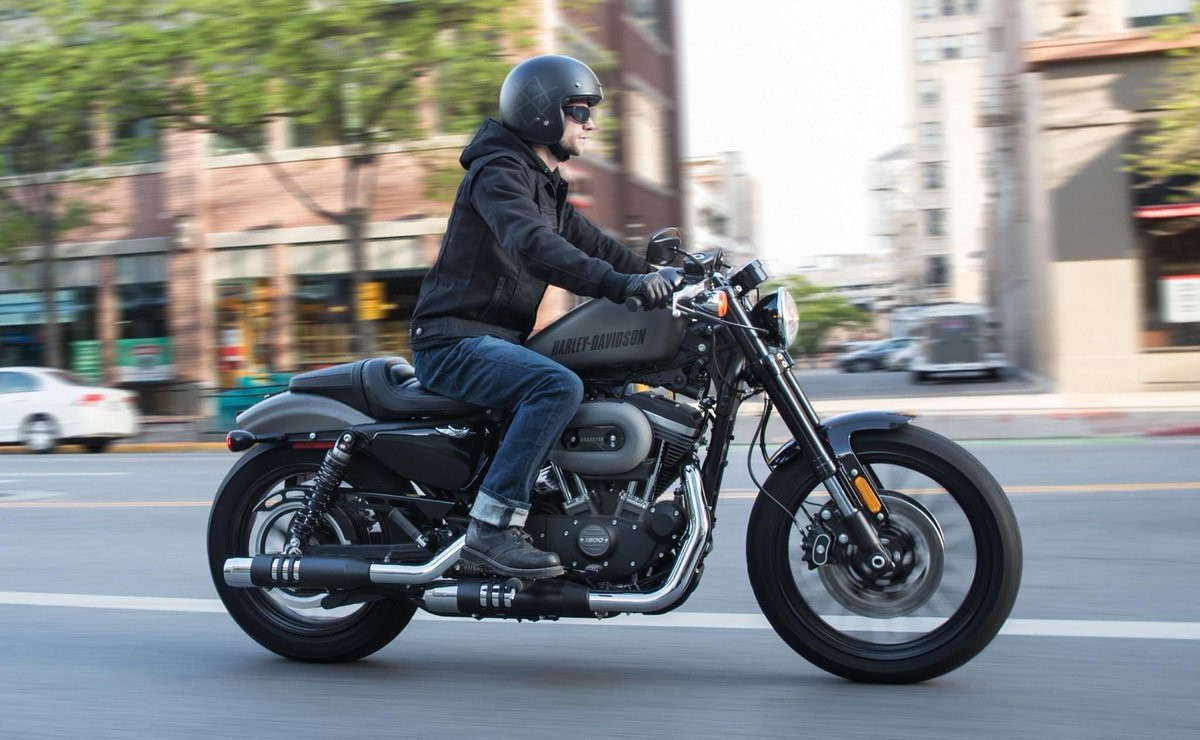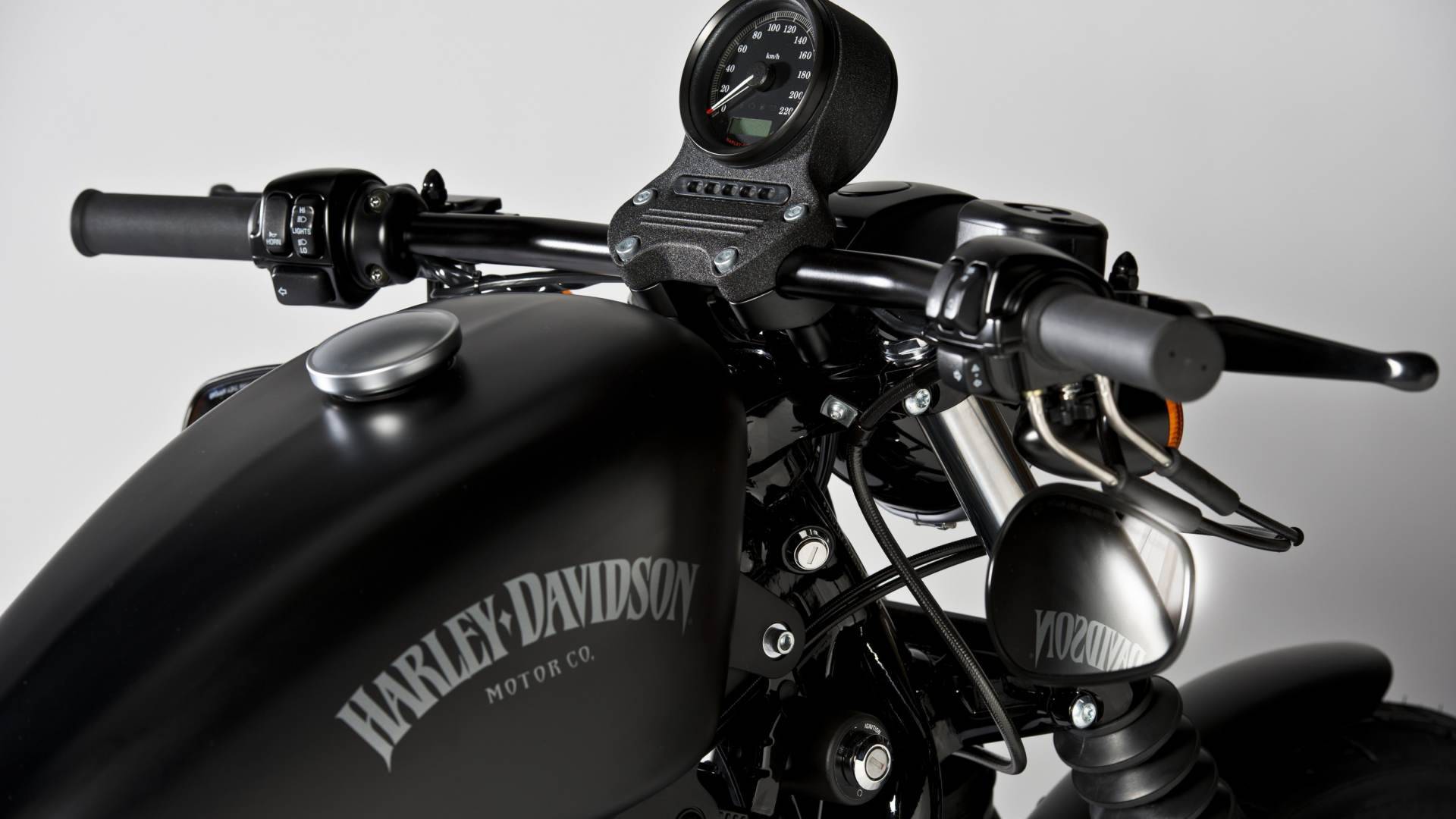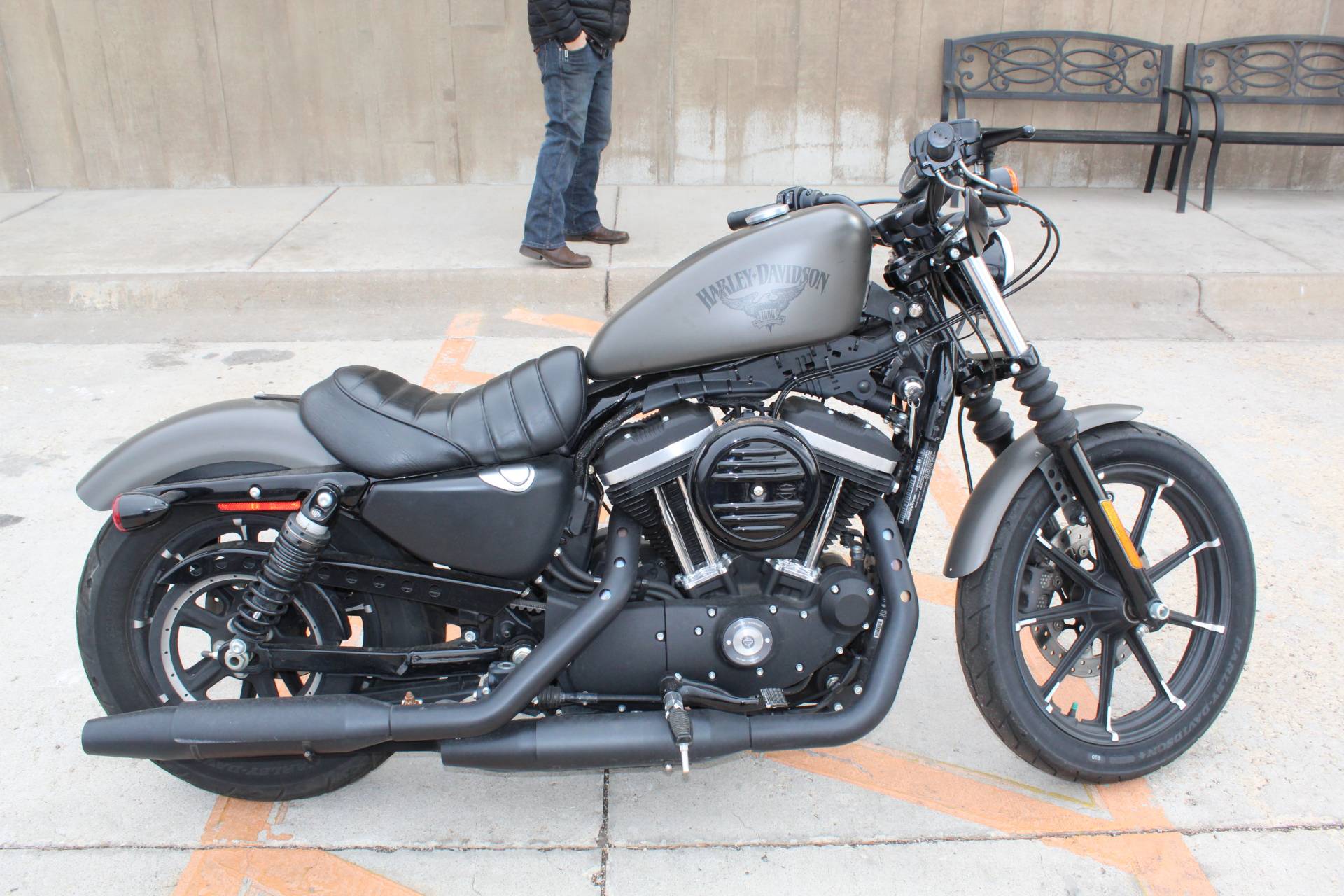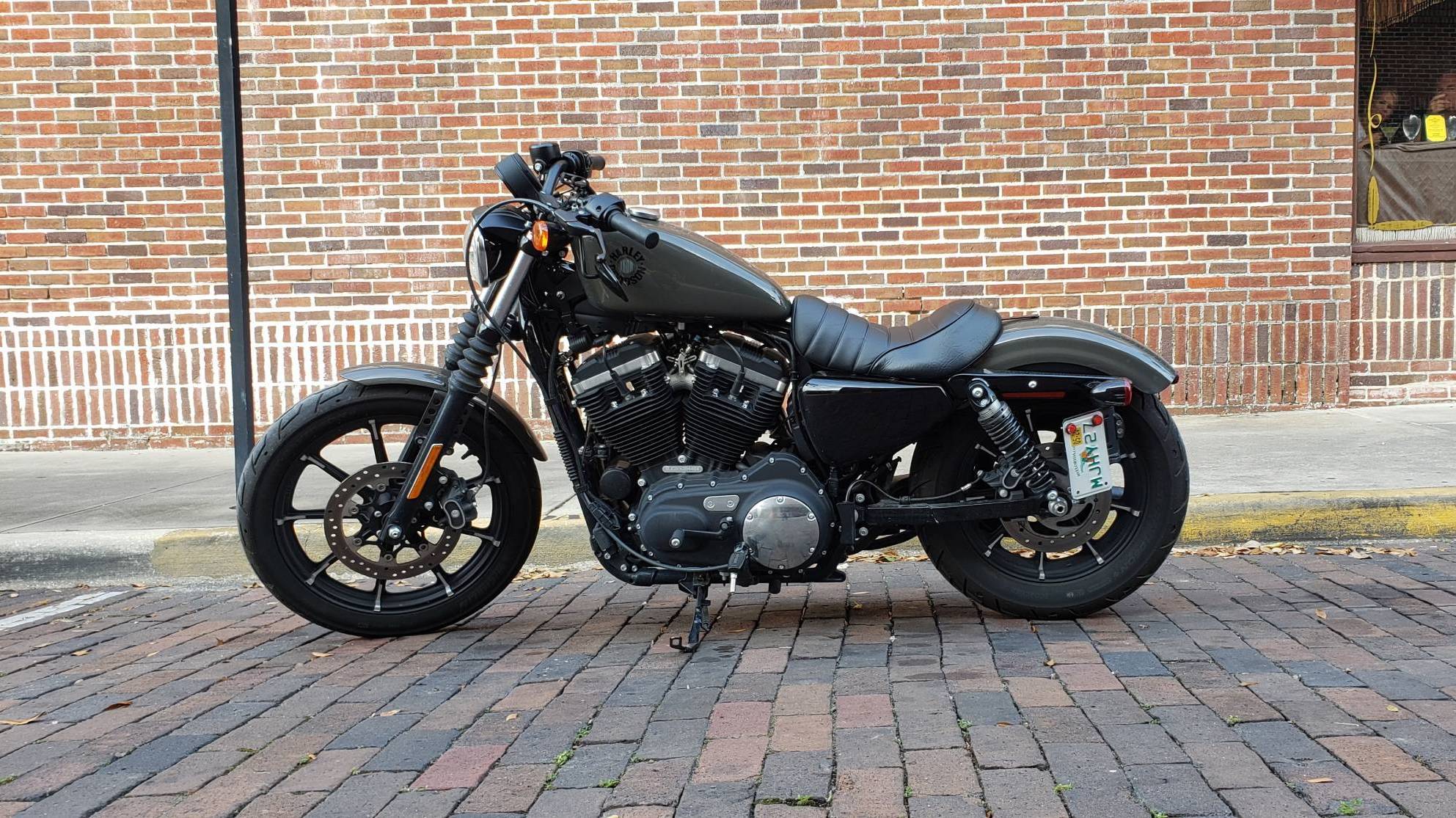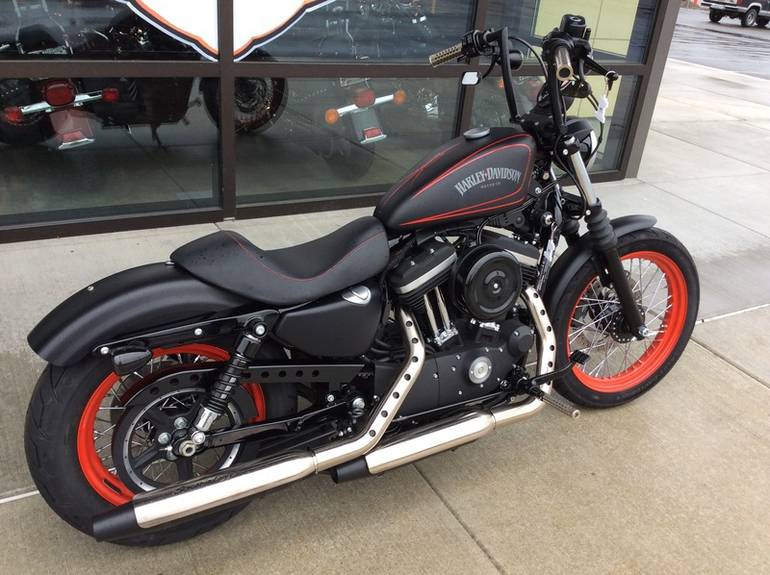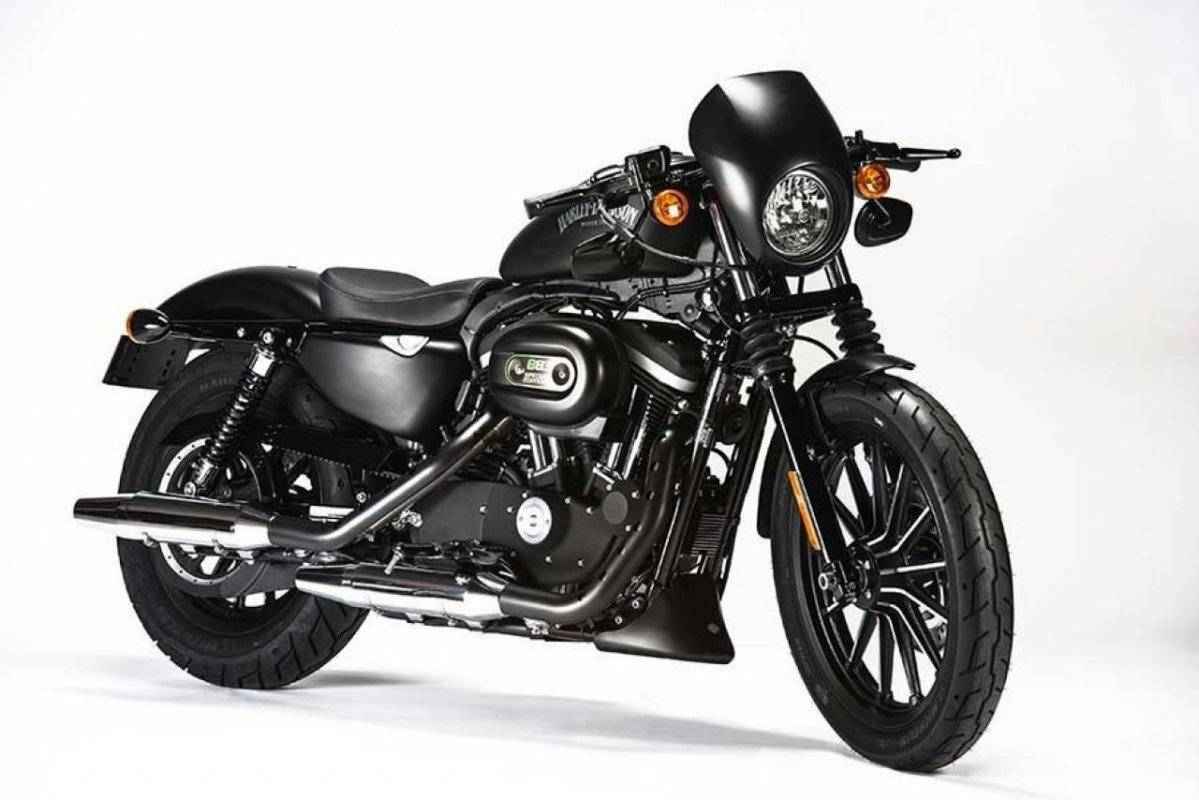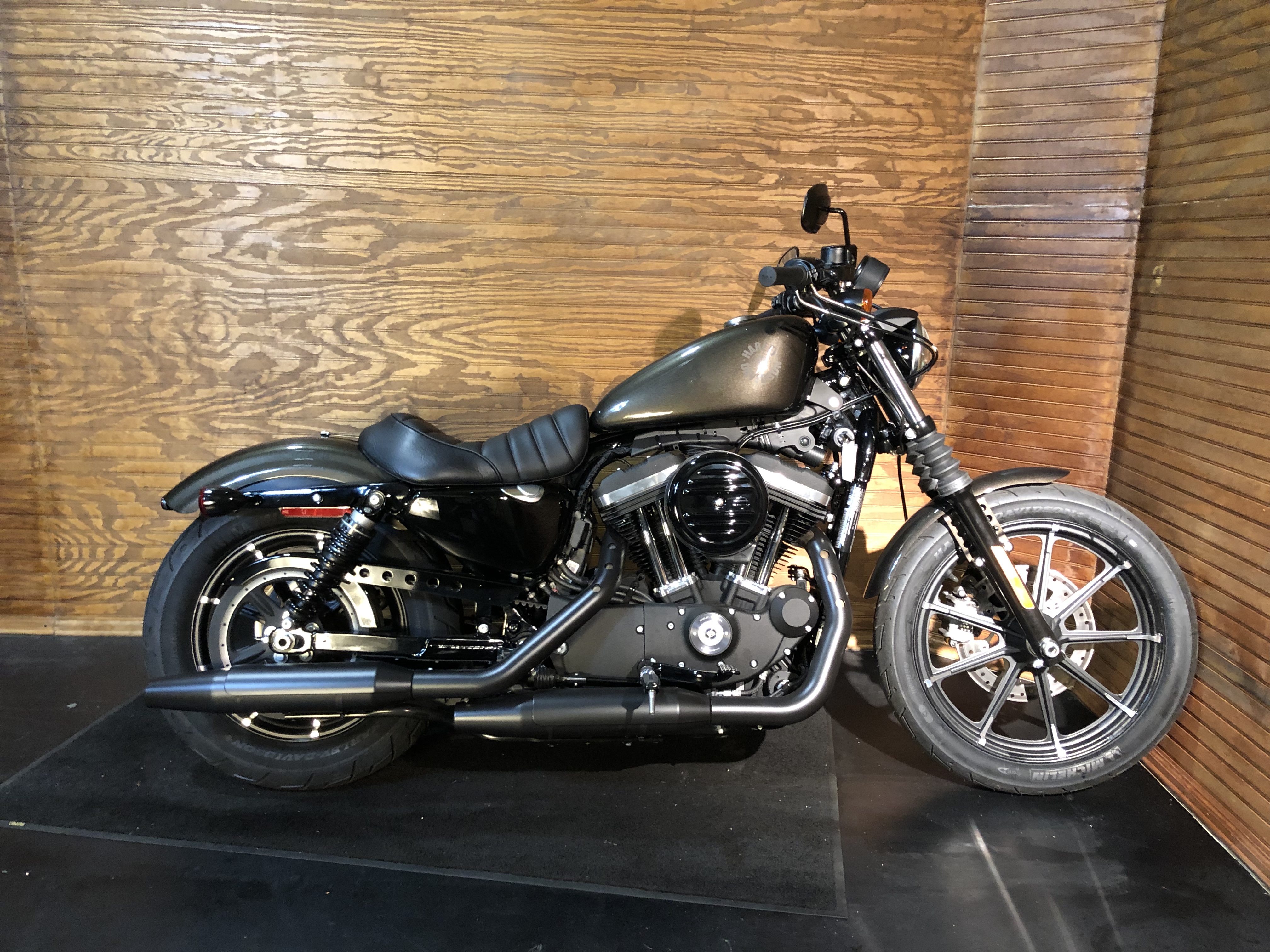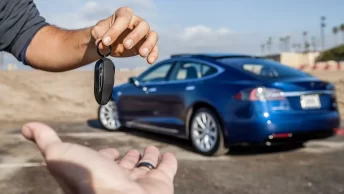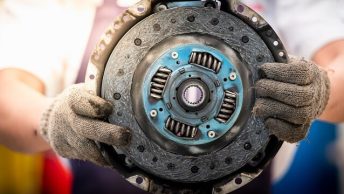Поведение на дороге
Любители уложить стрелку в затяжных прохватах посмеиваются над «Спортстерами». А ведь, по сути, перед нами тот же Harley Davidson Sportster Iron 883, слегка переосмысленный, и сравнивать его со спортивными японцами действительно глупо, он вовсе не предназначен для лихой езды на предельных скоростях. Сколько можно выжать из этого стиляги? Многие думают, что 120-140 — это его предел, да и то, рисковать так гнать стоит разве что, если надо оторваться от погони…
Как бы не так! Harley Davidson Iron 883 может разбежаться даже до 170 км/ч, а уж сорвавшись с места, на старте обойдет даже некоторые спорты. Правда, владельцы жалуются, что удержаться на 170 в седле нелегко, воздушные потоки просто срывают пилота с мотоцикла. Зато маневры, смена скоростей, внезапные торможения и старты — это родная стихия «Айрона». Он и предназначен для агрессивной езды, для современного города с пробками, светофорами и изогнутыми улочками. Все-таки, спортстер — это спортстер. Те, кто ощутил превосходство мотоциклов этого класса, вряд ли станут спорить с утверждением, что HD Iron 883 является одним из ярчайших его представителей.

009_moto_0612_022
.Stinger, зам. главного редактора «Мото». .Stinger, зам. главного редактора «Мото».
ОСОБОЕ МНЕНИЕ. Для меня, на тот момент плотно юзавшего Nightster, важнейшим моментом было: насколько меньше и хуже «883», нежели «1200»? Оказалось — сильно меньше. Динамика хорошего максискутера (или одноствольного кроссовета типа «полу-Гуся» — кому что ближе), не более того, а максималка — 160–165. А «Найт» и на 180 приборных катил вполне бодро. Вот только на «1200-й» максималке тебя пробирало от ужаса, а здесь моторчик совершенно адекватен шасси. Ну, может быть, кроме тормозов, да и то претензии к ним скорее по части «прозрачности», нежели динамики замедления. Отлично сбалансированный мотоцикл! Огорчило лишь, что усилие на рычаге сцепления столь же велико…
И не чоппер он, совсем не чоппер! Если у «1200-го» движок радовал о, неплохой на «середине» — и беспомощно обвисал «сверху», то здесь все ровненько — как на классиках европейской школы или приснопамятном «88-м твин-кэме». Да, со сброшенным газом не тронешься (но это нереально и на «1200-м»), а передачки приходится щелкать чуть чаще. Но — чуть, ввиду более широкого рабочего диапазона мотора.
Еще два отличия от XL1200 N — литые колеса и более низкий руль. К первому я отнесся нейтрально (они здесь вполне уместны, тем более, что дизайн их исконно спортстеровский), а вот руль порадовал. На «Найте» он был безбожно завышен, а здесь эргономика — то, что доктор прописал. В результате, в течение трех недель, что Iron был в редакции, я им пользовался чаще, чем длиттестовым Nightster.
Характерный «внеклассовый» силуэт, олдскульные ощущения на ходу («аэропланный» звук и характерные пульсации мотора, оружейное лязгание переключалки и т.д.) — это Sportster, настоящий Sportster. Рекомендую, настоятельно рекомендую. Вопрос лишь — в качестве чего? Если брать как мотоцикл «на все случаи» — пожалуй, все же нет. Короткоходная подвеска и не самая выдающаяся динамика ограничивают его использование городом-пригородом либо в качестве любимой игрушки для вечерних прогулок НЕмотоциклиста (хотя последний вариант, как показывает практика, среди соотечественников не теряет своей популярности). Я, скорее, вижу в «883» утилитарно-городское дополнение к большому дальнобойному мотоциклу (и необязательно «электричке»).
Только не покупайте его своей девушке — не бабская это тема! Тугая «сцепа», грубые манеры… Лучше доплатите за мягкий, более легкий в управлении и пышащий позитивом Dyna.
Мотоцикл Harley Davidson XL883N Sportster Iron 883 предоставлен .
Экипировка Rev’It!, Gaerne и Marushin предоставлена «ПРО Мото», экипировка Knox — магазином «Мобилайн»
Биплан: Harley Davidson XL883N Sportster Iron 883
Engine
3 out of 5 (3/5)
The engine in the Harley Iron 883 is both its biggest asset and its biggest weakness. It’s a proper Harley motor, so it’s a 45-degree air-cooled, pushrod operated, V-twin – just like most other Harleys have been since 1912. That means it sounds nice and rumbles around just like it should, unlike the water cooled Street 750 and Street Rod.
However it means it doesn’t create a great deal of power or torque (just 51.2bhp and 50.2ftlb respectively). To give it a decent bit of go it’s got a fairly low first few gears, however it’s also only got a five speed gearbox and a clunky one at that.
That also means it can feel a little revvy and breathless on the motorway. And while the air-cooling looks good, you do sit remarkably close to that rear cylinder, so it slow traffic and on hot days things can get a little warm in your trousers. There’s no two ways about it but the competition have the Iron licked here.
Reliability & build quality
4 out of 5 (4/5)
The air cooled Evolution motor in the Sportster range has been around so long now that all the major kinks have been ironed out. The only potential nasty that remains is the spring plate in the clutch, which is known to fail and can be an expensive fix.
It’s much cheaper (and easier) to just swap in a couple of extra clutch plates beforehand to stop it going wrong. Oil weeps from the rockerboxes aren’t unheard of, but it’s a cheap and easy fix. Apart from that it’s just a case of swapping the oil every 5000 miles.

Also like most Harley’s since the mid-80s, the engine has hydraulic valve lifters, so they never need a valve adjustment, while the final drive runs on a belt. Keep it adjusted properly and you can do over 60,000 miles without replacement.
On the whole build quality is good however there are a few issues that crop up regularly. The back of the front and rear mudguards are prone to rust, while the area below the fork seals are known to corrode. A liberal coating of XCP or ACF-50 should keep the worst of the problems away but, like all bikes, if you ride them in crap weather and don’t take care of them, they won’t respond well.
The bike
I wrote that previous sentence, of course, as a rabid fan of pretty much all old junk. The Sportster isn’t some Johnny-come-lately-with-no-model-history, like a Ducati Scrambler. Nor is it simply vintage-appearing parts slapped on a new bike, like a Yamaha XSR900. Alas, it’s not even a modern spin on a once-proud model, like the Indian Scout. Instead, the Sporty is a verifiably old heap.
The Sporty was officially kicked off in 1957 when Harley’s K received overhead valves and a new name. At that point, the Sportster was a hot bike, designed to end the ass-kicking that riders on British Triumphs and BSAs were delivering to riders on American bikes. The cranky old Ironhead engine soldiered along relatively unchanged through 1985, when the Evolution unit motor was developed. The Evo powering the 2016 Sporty is fundamentally the same one Harley served up to the world 30 years ago, and the whole bike as a package has stayed remarkably true to its original form. The Sportster didn’t get slower, the rest of the world just got faster since 1957.
The Sportster line dates back to 1957. Harley-Davidson photo.
The Iron 883 is not an imitation of a 1957 Sportster, or a styling homage to the past. It’s a direct descendant of the original, in an uninterrupted lineage. Harley-Davidson photo.
Normally, I don’t launch into a model’s history this much when reviewing a new motorcycle, but when the whole selling point of a bike is its stoically unchanging nature, it sort of seems… important. The Sportster has had upgrades over the years. Five-speed transmission (1991). Rubber mounting of the engine (2004). Fuel injection (first offered in 2004, standard in 2006). Upgraded front ends (the 35 mm fork came along in 1973, and 39 mm front ends were first used in 1988). Because of this, there is a plethora of aftermarket and OEM parts available to do whatever your heart desires. Cafe thing? Possible. Dual Sportster? Also possible. Seventies-style long bike? Yup.
The test mule I was on was the “Iron” flavor of Sportster: 883 cc, 562 pounds, and matte black everything, everywhere. Irons wear 16-inch rear wheels and 19-inch fronts. It’s the all-business, blacked-out traditional Sportster that also happens to be purty dang affordable. It’s the second cheapest bike in the lineup. It also boasts one of the stupidest names I think Harley has cooked up to date, behind the Bad Boy and the Crossbones. Iron? I’m pretty sure this bike does not have a single iron part on it. If it does, it sure ain’t a major component.
The Sportster trades on its Mr. Potato Head nature. If a rider doesn’t like something, he can simply change it out. Trying to review a Sportster as a modern motorcycle is not only impossible, it’s downright foolish. Here’s the quickest summary I can give you: If you want an entry-level, American-built cruiser that is very good right off the showroom floor, buy an Indian Scout. If you want to get your hands dirty and modify the snot out out a bike to make it exactly what you want, the Sporty is your machine.
Технические особенности
Как легко можно догадаться из названия модели, двигатель аппарата имеет рабочий объем 883 см3. Конечно, V-twin, какие могут быть сомнения? Это же HD!
6-ступенчатая коробка имеет некоторые особенности. Многие владельцы отмечают, что передачи переключаются со стуком. Но это нельзя однозначно отнести к недостаткам — шутят многие американцы, а уж для HD это стало даже своеобразной фишкой. Да и вообще, на фоне рёва мотора все остальные звуки просто меркнут.
Мотоцикл штатно оснащается довольно неплохой тормозной системой. Оба колеса имеют двухдисковые тормоза, и если пилот отточит мастерство управления, останавливать байк он сможет за считаные мгновения. Можно пользоваться и одним из тормозов, а не парой, но это весьма непросто. Масса мотоцикла недостаточна для этого маневра, его будет заносить. Производитель предоставляет покупателю возможность при покупке установить систему АБС, конечно, за дополнительную плату.
Подвеска осталась жесткой, но надежной. Владельцы отмечают, что поначалу она может показаться неудобной, однако к ней можно привыкнуть. Если вы задумываетесь о приобретении этого байка, учтите, что у него очень небольшой дорожный просвет. Закладывание в вираж может повредить трубы или подножку. Да и не для любой местности подобная особенность может быть удобна.
She Said
My wife and fellow motorcycle writer, Allyn Hinton, says “My husband’s Sportster 883 has been so good to us. It’s not the bike I want to ride pillion on, but for a little around-town ride, it’s pretty awesome. New in 2016, Harley added the bobber-style tuck-n-roll seat. Originally called “Blacksmith” during the concept and design phase, Harley Senior Designer, Dais Nagao, wanted the Iron 883 to be a factory bobber and incorporate elements that he would put on his own bike, such as raised-fin air cleaner cover, the eagle tank emblem, bullet-hole design features, and machine-cut-edge spokes for a new identity and to reduce weight. How can you not love a bike that was designed by a man who eats, sleeps, lives, and dreams bikes and has since he was a little kid?”
Sportster Iron lowlights
So here’s the thing. I like Sporties… for other people. This is not a good Lem-lem bike due to our discrepancy in size, but as I mentioned in the video, there are some aspects of Sportster ownership that are universally awful for all riders aboard them.
Four dots showing on the shock was the preload setting that kept the suspension from bottoming with my considerable weight on top of it. The downside to this is that it reduced travel to right around an inch, which is not much. Ergo, the rear of this bike felt very, very hard. I myself am harder than woodpecker lips, so it would be fine if this was my solo bike, but if I set this bad boy up for Mrs. Lemmy-hauling duty, these shocks would have to go. Still, it beats bottoming on every bump like the older Irons. RevZilla photo.The first is the ass-pounding Irons deliver. The new rear suspension is a huge improvement over the old setup, but it still leaves a lot to be desired. I found it was a sporting ride for my 275 pounds with four adjustment dots showing above the lockrings. I was mostly able to keep anything from dragging through the turns, except for the hero blobs, which are supposed to drag. That hasn’t always been the case with the 2013 Iron we kept in the studio for a few years. I wreck every exhaust we put on that thing.
If you plan on riding two-up, fit taller shocks. The main issue with the stiffness and parts dragging is the sub-two-inch travel. After I had preload dialed in, the rear had about one inch to move. It’s just not enough. For whatever reason, the standard tall Sportster suspension hasn’t been available for years. Now, every model seems to be a Low, Custom, or some other less-than-usable, slammed-rear model, probably because they look cool and the low seat height is a great selling point for many riders. The seat on this bike is beautiful, but not at all conducive to long days in the saddle. The seat and the shocks together paired up to ruin my rear.
Next up is the footpeg scenario. These things are like dual-sport pegs, just tiny. They are truly tiny. Worse still, there are no passenger footpegs. Nor is there a passenger seat. I have to pay extra to have my wife ride along? This sucks. Oh… and you need to buy more than a saddle and pegs. You’ll be purchasing the mounts, too. I didn’t install any, but I have this sneaking suspicion that the rear pipe has to be removed — or at least loosened — to pop the mounts on. Good thing I like wrenching.
I love Harley-Davidson powerplants; this is not a secret. I adore them in spite of their shortcomings, but this bike was piddling lots of oil for a bike that was pretty close to new. RevZilla photo.
Also, I generally wanted more power. There’s a million ways to fix that. But I want more. Still, the amount supplied is not bad, given the fairly low cost of admission. Uh, let’s get back to that oil leak I mentioned earlier. This bike was pissing oil. I was personally unfazed. I have H-D’s in my garage that are very old machines. Oil leaks are a way of life when the oil container is above the engine, because gravity always wins. But riders without a soft spot for Harleys might be pretty dismayed at my test unit puking this much oil with 1,600 miles or so on the ticker. It could have been a simple overfilling situation, but I think it was deeper than that. It wasn’t leaking from the breathers. Rather, this bike was leaking up near the oil filter, blowing back onto both cases and onto the front motor mount. I didn’t pull the bike apart, but it was a little embarrassing for such a new bike.
There are a million things I would change about the Sportster for myself if I had one. But, this is the draw of the Sporty. You’re buying the base for a bike, not a complete motorcycle. Approach it with that mindset, and the lowlights all seem pretty minor.
Sportster Iron highlights
It is my job to be impartial, but I would be lying if I said that I always am. As such, one of my favorite parts about the Sportster is the mill. This V-twin sounds great, is punchy low in the rev range, and can cruise around in a relaxed, lopey manner when asked. The engine is infinitely tailorable, as well. You can add some simple bolt-ons to score some easy horsepower, or get a little crazier and turn the Sporty into a straight-up brawler. Pulling a hundred ponies out of a street-ridden Sporty is not particularly difficult, and makes for one hell of a street sleeper, if you’ve got the time and money to do it. You can make your Evo a high-rev screamer, or just set it up to be a grunty locomotive on the street. The engine is a chameleon. Properly selected aftermarket parts will yield a surprising range of options, cementing the Evo Sporty’s flexibility.
General quality (fit and finish) is always exceptional on these bikes. For a low-rent Harley, the Iron is put together with obvious pride. Finishes are deep and well applied, and there’s not a flimsy part on this bike. Unlike its competition, if you see it on the Sporty, odds are excellent it’s a quality piece. Metal switch housings, a metal air cleaner, metal fenders, metal headlight… the Sporty uses far less plastic than most of its brethren. (Honda, plastic sidecovers? Really?) There are plenty of pieces on competitors that feel flimsy, and the Sporty inspires confidence everywhere you touch it. (Notice how nice the sheetmetal is. Notice the total absence of a pinch weld seam, à la Yamaha Bolt.) This is a bike that will happily take a beating for years.
I also like the maintenance schedule on these bikes. Change the oil, change the primary fluid, and you’re done. Spark plugs are a breeze. Granted, the Sporty has both primary and engine oil that need to be changed, but the plugs are right near each other. It’s an easy task. The Sporty has hydraulic lifters. You check valve clearances… never. The Sporty’s belt is nearly maintenance-free. Do the oil changes, keep on top of the battery, and toss a set of plugs in it once a season, and the bike will last seemingly forever. These are tough little cookies. I believe Lance spent the better part of the 1990s tooling around Puerto Rico on a Sportster that by all accounts was quite reliable.
Conclusion
I’ll never buy this bike. It just doesn’t fit me. I cannot get comfy on a Sporty that’s built on a stock frame. But plenty of normal-sized people will fit and will purchase, and bully for them. The Iron is not the best bike in a performance sense, but it is exactly what it promises to be: more of the same. And I don’t mean that in a negative way. The Sportster is long-running, long-lived, reliable, and stable. And while new-bike junkies may not appreciate a bike that doesn’t change, Luddites and tinkerers sure will.
If you’re contemplating purchasing an Iron, understand it’s like going to the pizzeria and buying pizza dough… for the same cost as buying the whole pizza. It may not be the cheapest way to buy a pie, but if you know what you are doing, you’ll probably end up with a pizza that’s exactly the way you want it.
Value vs rivals
4 out of 5 (4/5)
The purchase price of an Iron 883 is similar to the big rivals, namely the Indian Scout Bobber and the Triumph Bonneville T100, although they do come with more ‘stuff’ as standard.
Where the Iron 883 really comes into its own is five years down the line.
This model came out in 2015 and you’d struggle to find a nice one for much less than £5500. Older models hit a price floor of £4000 as long as they’re in good nick. If you buy a cared for used model and take care of it yourself, it’s easy to sell it for exactly what you paid.
Alongside the Scout and the Bonnie mentioned above, other rivals to the Iron 883 include the Honda CMX500 Rebel, Ducati’s Scrambler 800 range, Moto Guzzi’s V7 and V9, plus the Kawasaki W800. You could also consider the Kawasaki Vulcan S, Yamaha XV950 range and Harley’s own Street Bob.
Двигатель Harley-Davidson Iron 883
Предельная скорость байка – 170 км/час, но при этой скорости седока просто сдувает. Мотор 4-х тактный, 2-х цилиндровый, V-образный, мощность которого – 52 «лошадки» при 5750 оборотов в минуту. Пик крутящего момента – 70 н/м при 3750 оборотов в минуту. 6-ти диапазонная коробка скоростей «механика». Данный Harley-Davidson Iron 883 проектировался не для долгой езды на большой скорости – он предназначен для крутых поворотов, узких городских проулков и агрессивного движения.
И в этом случае он шикарен – скорость Харлей-Дэвидсон Ирон 883 набирает достаточно быстро и бодро, оставляя сзади многие мотоциклы. Но, пока не дойдет до 100 км/час, тогда его быстрая энергия пропадает. Шести диапазонная коробка скоростей байка работает неплохо, но довольно грубо, при переключениях слышен стук, но это обычно для штатовских мотоциклов. На практичности это не ощущается, а шум мотора и коробки передач – особенность устройства транспортного средства.
Тормозная система достаточно эффективна – это 2 диска по 1-му на колесо, останавливают байк достаточно хорошо, только тогда, когда используешь оба тормоза и задний, и передний. Для быстрого торможения тормозом только спереди Харлей-Дэвидсон Ирон 883 достаточно тяжелый, не глядя на то, что эта модель одна из легкий в линейке Харлей, кроме марки Sportster. Во время приобретения байка, есть возможность приобрести за доп. плату структуру ABS.
Некоторые изменения произошли в подвесках, их взяли от модели Sportster и немного усовершенствовали, но они такие же жесткие и практичные. С данными подвесками не ощущаешь «плавания» на трассе, во время резких маневров. Но, небольшая база колес и малая масса, не очень широкое заднее колесо говорят о том, что боковой ветер во время продвижения на Харлей-Дэвидсон Ирон 883 ощущаешь в полной мере, особенно во время проезда по трассе через открытые места и поля.
Но ездить на мотоцикле в дальние дороги не желательно, так как он не столько комфортен, да и 13-ти л. топливного бака хватит только на 200-250 км проезда без заправки байка, это в том случае, если слишком не «газовать» при продвижении.
Если подумать, этот мотобайк все такой же Sportster, только немного переработанный. В принципе, Harley-Davidson Iron 883 весьма мощный и комфортный – натуральный хулиган в городском потоке.
Подвеска спереди – это телескопическая вилка. Подвеска сзади – маятниковая с 2-мя амортизаторами.
Тормозная система спереди – дисковая, гидравлическая с двойным поршневым суппортом. Тормозная система сзади — дисковая, гидравлическая с двойным поршневым суппортом.
Вид впуска – инжекторный, структура охлаждения – воздушная. Структура запуска силовой установки – эл. стартер.
Harley-Davidson Iron 883 Drivetrain
- 883 cc Evolution engine
- 53.8 lb-ft of torque
- Rubber-mounted engine for reduced vibration
- Lively performance
When the first Evo Sporty came out, I really didn’t like the engine. Personally, I didn’t see anything wrong with my old Ironhead. But history is a great teacher, and the Evo has had plenty of time to prove its toughness and longevity. I would go so far as to say it’s one of the best engines Harley ever made, and they’ve had 30 years to perfect it. The new Milwaukee-Eight engines have so far proved promising, but they haven’t been out long enough to know if they’ll match the Evo’s reliability and longevity.
In keeping with Harley tradition, the mill is an air-cooled, 45-degree V-twin. The 3-inch bore and 3.811-inch stroke give the engine a total displacement of 53.9 cubic-inches (883 cc — hence the devilishly clever name), and a throttle body with electronic fuel injection helps it crank out 53.8 pound-feet of torque at 3,750 rpm. This is plenty of power for zipping around town, and it comes economically at 51 mpg.
A five-speed transmission and reinforced-belt final drive connect the engine to the wheel, and while it doesn’t have the sixth gear of its Big-Twin cousins, you really won’t miss it much. Unlike Sporties from the past, this engine has rubber mounts that isolate the frame and rider from engine vibration. So take that, Harley haters! Sportsters no longer come with a leather-bound bottle of Loctite!
| Engine : | Air-cooled, Evolution |
|---|---|
| Bore x Stroke: | 3 inches x 3.811 inches |
| Displacement: | 53.9 cubic inches (883 cc) |
| Compression Ratio: | 9:1 |
| Engine Torque (J1349): | 53.8 pound-feet at 3,750 rpm |
| Fuel System: | Electronic Sequential Port Fuel Injection (ESPFI) |
| Exhaust: | Black exhaust headers and black mufflers |
| Primary Drive Chain: | 34/57 ratio |
| Final Drive: | Belt, 29/68 ratio |
| Clutch: | multi-plate, wet |
| Transmission: | 5 speed |
| Gear Ratios (overall): | 1st: 10.41, 2nd: 7.436, 3rd: 5.531, 4th: 4.584, 5th: 3.931 |
Harley-Davidson Iron 883 Chassis
- Low center of gravity
- Quick reversals
- Crisp steering response
- Optional ABS
As I mentioned before, the Iron 883 is a short bike no matter how you measure it. The wheelbase is a mere 59.6 inches, even with the relatively long, 30 degree rake. Steering geometry winds up giving you 4.6 inches of trail for crisp response to steering pressure, and even though the maximum lean angle is only 27 degrees to the right and 28 degrees to the left, you will be able to quickly traverse the bike from one max to the other.
Harley keeps the Iron 883 low with a slammed rear suspension, 16-inch tire in back and 19-inch hoop in front. Sportsters traditionally have tall seats, but this one comes with a saddle height just a hair under 30 inches high, unladen, in a move sure to appeal to the vertically challenged crowd. Ground clearance is a bit low at 5.5 inches, but you aren’t going off-road with this bike and the low center-of-gravity is a nice bonus.
The Iron 883 weighs in at 564 pounds soaking wet, so the lack of dual front brakes isn’t that big a deal. Both ends of the bike get strong, honest braking from the dual-cylinder calipers, and you have the choice of going “old-school” with non-augmented brakes or going for the safety net offered by the optional ABS package.
| Frame: | Mild steel, tubular frame; circular sections; cast junctions |
|---|---|
| Swingarm: | Mild steel, rectangular tube section, stamped junctions; MIG welded |
| Front Forks: | 39 mm |
| Rear Shocks: | Coil-over; Preload Dual-adjustable |
| Suspension Travel, Front/Rear: | 3.6 in / 1.6 in |
| Rake (steering head): | 30° |
| Trail: | 4.6 inches |
| Lean Angle, Right/Left: | 27 degrees/ 28 degrees |
| Wheels: | Black Nine-Spoke with Machined Highlights |
| Wheel, Front: | 19 in. x 2.15 in. (483 mm x 55 mm) |
| Wheel, Rear: | 16 in. x 3 in. (406 mm x 76 mm) |
| Tire, Front: | 100/90B19 57H |
| Tire, Rear: | 150/80B16 77H |
| Brakes, Front: | 300 mm disc, dual-piston caliper |
| Brakes, Rear: | 260 mm disc, dual-piston caliper |
| ABS: | optional |
Harley-Davidson Iron 883 Specifications
| Engine & Drivetrain: | |
|---|---|
| Engine : | Air-cooled, Evolution |
| Bore x Stroke: | 3 inches x 3.811 inches |
| Displacement: | 53.9 cubic inches (883 cc) |
| Compression Ratio: | 9:1 |
| Engine Torque (J1349): | 53.8 pound-feet at 3,750 rpm |
| Fuel System: | Electronic Sequential Port Fuel Injection (ESPFI) |
| Exhaust: | Black exhaust headers and black mufflers |
| Primary Drive Chain: | 34/57 ratio |
| Final Drive: | Belt, 29/68 ratio |
| Clutch: | multi-plate, wet |
| Transmission: | 5 speed |
| Gear Ratios (overall): | 1st: 10.41, 2nd: 7.436, 3rd: 5.531, 4th: 4.584, 5th: 3.931 |
| Chassis: | |
| Frame: | Mild steel, tubular frame; circular sections; cast junctions |
| Swingarm: | Mild steel, rectangular tube section, stamped junctions; MIG welded |
| Front Forks: | 39 mm |
| Rear Shocks: | Coil-over; Preload Dual-adjustable |
| Suspension Travel, Front/Rear: | 3.6 in / 1.6 in |
| Rake (steering head): | 30° |
| Trail: | 4.6 inches |
| Lean Angle, Right/Left: | 27 degrees/ 28 degrees |
| Wheels: | Black Nine-Spoke with Machined Highlights |
| Wheel, Front: | 19 in. x 2.15 in. (483 mm x 55 mm) |
| Wheel, Rear: | 16 in. x 3 in. (406 mm x 76 mm) |
| Tire, Front: | 100/90B19 57H |
| Tire, Rear: | 150/80B16 77H |
| Brakes, Front: | 300 mm disc, dual-piston caliper |
| Brakes, Rear: | 260 mm disc, dual-piston caliper |
| ABS: | optional |
| Dimensions & Capacities: | |
| Length: | 85.8 in |
| Seat Height, Laden: | 25.7 in |
| Seat Height, Unladen: | 29.9 in |
| Ground Clearanc: | 5.5 in |
| Wheelbase: | 59.6 in |
| Fuel Capacity: | 3.3 gals |
| Fuel Economy: Combined City/Hwy: | 51 mpg |
| Oil Capacity (w/filter) : | 2.8 qts |
| Weight, As Shipped: | 545 lb |
| Weight, In Running Order: | 564 lbs |
| Gross Vehile Weight Rating: | 1000 lbs |
| Gross Axle Weight Rating, Front/Rear: | 335 lb / 665 lb) |
| Electric: | |
| Battery (per Battery Council International Rating): | Sealed lead acid, maintenance-free, 12V, 12 amp/hour, 200 cca |
| Charging: | Single-phase, 30-amp system (375W @ 13.5V, 2000 rpm, 405W max power @ 13.5V) |
| Starting: | 1.2 kW electric with solenoid shift starter motor engagement |
| Lights (as per country regulation): | |
| └ Headlamp: | Quartz Halogen, 55-watt low beam, 60-watt high beam |
| └ Indicator Lamps: | High beam, neutral, low oil pressure, turn signals, engine diagnostics, low fuel warning, low battery, security system (if equipped), ABS (if equipped) |
| Gauges: | Handlebar-mounted electronic speedometer with odometer, time-of-day clock, dual tripmeter, low fuel warning light, low oil pressure light, engine diagnostics readout, LED indicator lights |
| Details: | |
| Warranty: | 24-month unlimited mileage |
| Model ID: | XL 883N |
| Colors: | |
| └ 2016: | Olive Gold, Charcoal Denim, Black Denim, Hard Candy Gold Flake |
| └ 2017: | Black Denim, Charcoal Denim, Olive Gold, Red Iron Denim, Hard Candy Hot Rod Red Flake |
| └ 2018: | Black Denim, Industrial Gray Denim, Wicked Red, Bonneville Salt Denim, Hard Candy Chameleon Flake |
| └ 2019: | Black Denim, Industrial Gray, Wicked Red, Rawhide Denim, Rugged Gold Denim, Silver Flux/Black Fuse |
| └ 2020: | Black Denim, Barracuda Silver Denim, River Rock Gray, Scorched Orange/Silver Flux |
| └ 2021: | Black Denim, River Rock Gray Denim, Deadwood Green, Snake Venom |
| Pricing: | |
| └ 2016: | Color: $8,849, Hard Candy Color: $9,299 |
| └ 2017: | Color: $8,949, Hard Candy Color: $9,399 |
| └ 2018: | Color: $8,999, Hard Candy Color: $9,449 |
| └ 2019, 2020: | Color: $8,999, Two-Tone Custom Color: $9,899 |
| └ 2021: | Color: $9,499, Custom Color:$10,199 |
Harley-Davidson Iron 883 Competitors
So far, the closest bike to the Iron 883 would have to be the Bolt from the Star cruiser lineup at Yamaha. Both bikes follow a similar low-and-compact design, with minimal sheet metal and plenty of entry-level appeal.
Yamaha Bolt
The Bolt comes out on top of the displacement category with 58 cubic-inches (942 cc) versus 53.9 cubic-inches from the Harley. Both engines are air-cooled V-twins, and really, the biggest difference in the engines is the angle of the dangle – Harley runs its customary 45-degree engine while the Bolt uses a 60-degree mill. What does that mean other than aesthetics? Since neither are off-roaders or flat trackers, it may only come down to a difference in the exhaust note.
At $7,999, the Bolt comes in a tad under the Sporty’s $9,499 price tag, and the difference is even bigger if you start looking at the custom colors available from Harley. While the price difference is not that big, I would point out that every dollar counts in an entry-level budget, and the Bolt looks to give the Iron 883 some serious competition in the domestic market.
Read our full review of theYamaha Bolt.
Harley-Davidson Iron 883 — краткий обзор
Harley-Davidson Iron 883 / Харли-Дэвидсон Айрон 883
Байк Harley-Davidson модели Iron 883 — лучший способ познакомиться с американской мотокультурой. Каплевидный топливный бак, укороченные крылья и оригинальный двигатель пронизаны духом кастомайзинга. Мотобайк оснащен новой тормозной системой, четко реагирующей на нажатие райдера, что существенно улучшает управление на всех дорогах при любых условиях.
В мотоцикле Harley-Davidson Iron 883 удачно сочетаются стиль и качество исполнения. Его безопасность обеспечивается антиблокировочной системой. Кроме этого, байк получил новые эргономичные и удобные органы управления. Он стремительный и маневренный, его конструкция усилена дуплексной тонкотрубной рамой, выполненной в классическом стиле.
Двигатель Harley-Davidson Iron 883 с электронным впрыском и жидкостной системой охлаждения обеспечивает тяговое усилие, достаточное для комфортного и динамичного передвижения. Системы двигателя контролируются электроникой, а о компенсации избытка тяги просигнализирует трекшн-контроль.
Overall rating
4 out of 5 (4/5)
Sorry haters, but the Harley-Davidson Sportster 883 Iron is a good bike for an entry level cruiser. Those last five words are key. Compared to another entry level middleweight, say a Yamaha MT-07, the Harley Iron 833 looks all kinds of bad (especially if you only refer to the spec sheet).
But compared to other entry level cruisers, it’s a no-nonsense, no gimmicks fun machine. It’s also not trying to be a Harley-Davidson, like the Honda CMX500 Rebel or Kawasaki Vulcan 650 for instance, which counts for a lot.
- Latest news: Harley-Davidson Sportster set to go off sale in 2020
- Related: Best cruiser motorcycles
- Related:Best first big bikes
It’s a hard thing to explain but the Iron 883, like many other Harleys to be honest, has a certain something that makes it more than the sum of its parts. They are without doubt expensive, underpowered and overweight but they’re also really brilliant hunks of metal too.

It has a heavy clutch, its brakes are relatively poor, it’s slow steering, the engine is comparatively clunky (as is the gearbox) and the rear cylinder gets uncomfortably hot in traffic – but it does look and feel like a genuine Harley and that shouldn’t be underestimated.
Compared with the Street 750 (Harley’s old entry-level hog), the 883 has cleaner lines with its purer, simpler design and the lack of a radiator. Then there’s the iconic ‘peanut’ tank, twin, side-mounted exhausts, classic cut-down rear ‘fender’ and ‘drag’ style bars. If you removed the H-D badge from the Iron you’d still be in no doubt who made it.
Riding the 883 feels good – and that’s what matters most. It doesn’t feel like riding an imitation of a Harley – it feels like the real deal.
There’s a thriving enthusiast community for Harley-Davidsons run by the firm itself called HOG – Harley Owners’ Group.
This bike is also very popular with those who like to personalise their motorcycle. It appears in our Best Custom Motorbikes article. Mutt Motorcycles even created their own custom blacked-out Iron 883 in 2018.
Harley-Davidson Iron 883 Design
- Drag-centric styling
- LED lighting
- Generous blackout
When the folks at Harley-Davidson introduced the K-model (direct ancestor of the XL, or Sportster line) back in 1952, I doubt they could have known they were birthing a genre that would still be thriving over half a century later. Yet, here we are with the 2021 Sportster Iron 883 that pays tribute not so much to the factory, but to the custom touches added by owners over the ages.
Overall, the Iron 883 has a drag-centric vibe that is hard to ignore. The drag bars and mid-mount controls form an aggressive rider triangle that puts the rider into a slightly forward-leaning stance – a perfect cornering position if you like — to take your curves with a little mustard on them.
Typical of the Sportster family, the lines are rather bunched up to fit within the 85.8-inch total length. The fuel tank emulates the classic look of the Sporty peanut-tank while squeezing another gallon or so in there for a total of 3.3 gallons. Let’s face it, peanut tanks are cool to look at, but they just don’t carry enough fuel.
The upper lines manage a little flow down the tank and across the rolled-leather that sort of pimps out the otherwise-mundane stock Sportster seat, which is more comfortable than the smooth Sporty seat. The chopped rear fender adds to the dragster vibe while leaving a good view of the rear tire.
Turn signals — front and rear — use LEDs to keep the units as small and unobtrusive as possible. The taillight is so low-profile it looks more like a strut reflector, or it does when it isn’t lit, anyway. A sideways license-plate holder mounted on the left side keeps the fender clean and the top line unobstructed at the rear end – plus it makes the Iron 883 look like a worked-over custom bike right off the showroom floor.
Harley took the blacked-out look to the Nth degree. Even the shock springs and turn-signal housings got the treatment, leaving only the pushrod tubes, fork tubes (but not lowers), wheel-spoke tips, and engine-cover fasteners as the only bright spots on the bike. This also plays into the custom look, and ironically, this seeming lack of frills is actually a frill all its own.
If you’re one of those unfortunate folks that have to put your bike into storage for a few months of the year, you’ll appreciate the addition of the battery tender harness as standard equipment in 2017.


